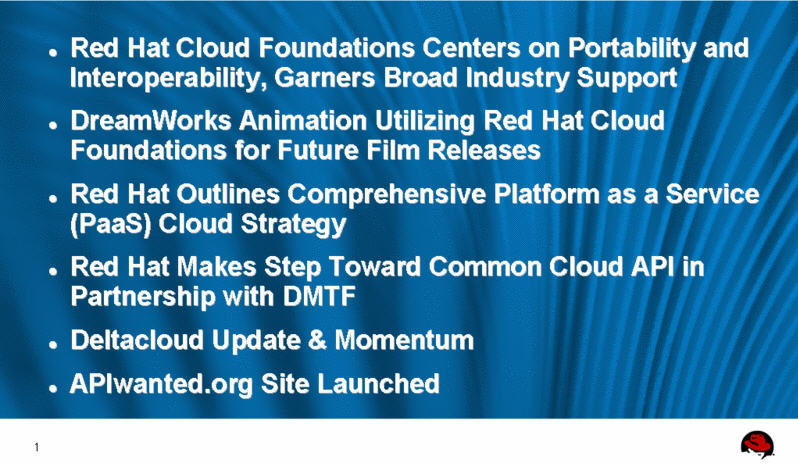Red Hat sets its cloud strategy, touts portability, eyes Microsoft Azure alternative

Red Hat on Wednesday took the wraps off its cloud computing strategy, which revolves around promoting interoperability and application portability.
In a nutshell, Red Hat's cloud strategy includes platform-as-a-service, a JBoss middleware effort to allow open developer choice and moves aimed to put the company in the middle of cloud applications.
Paul Cormier, president of Red Hat's products and technology business, said Red Hat is aiming to align all of its products with cloud computing. In Cormier's view, there are only two companies that can provide a stack of cloud-enabled enterprise software---Red Hat and Microsoft.
The takeaway: Red Hat is positioning itself as the open source cloud provider and as an alternative to Microsoft's Azure platform. The company touted a cloud computing win with Dreamworks Animation. Red Hat's take: No customer should be locked into a cloud platform.
Red Hat executives said that companies will be increasingly managing hybrid cloud infrastructure. The company's plan is to be in the middle of those hybrid environments (statement). It should be noted though that the cloud governance game that Red Hat is entering also includes a bevy of other players ranging from BMC Software to CA to Hewlett-Packard and IBM.

At a higher level, Red Hat is also aiming to box in virtualization rivals such as VMware and Citrix as one-trick server ponies. Oracle also aimed to do something similar with its virtualization strategy. Among the key moving parts of Red Hat's cloud plans:
- Red Hat's platform-as-a-service (PaaS) strategy will revolve around the JBoss middleware. This offering will be designed to allow companies, cloud and software-as-a-service (SaaS) providers to build and deploy applications.
- JBoss will aim to be flexible to accommodate multiple development frameworks ranging from Java to Spring to Ruby and others.
- JBoss cloud images will be available in Red Hat's software as well as Amazon EC2 and Windows Hyper-V.
- Red Hat's PaaS effort will have containers for transactions, messaging and integration. The idea here is that Red Hat will move beyond just simple containers.
- The company has submitted its application programming interfaces (APIs) for Apache Deltacloud to the Distributed Management Task Force (DMTF). This move is designed to foster adoption.
- Red Hat will focus on enterprise applications consistency with its Cloud Foundations portfolio of software.
- The company touted partnerships with the likes of Intel, Symantec and Wipro.
The moves make a lot of sense and position Red Hat well. After all, lock-in concerns are a big issue for technology executives investigating cloud computing. Given that Red Hat has many of the pieces for cloud computing the strategy positions the company as more of a Switzerland as other vendors pitch their IT wares.
In other words, Red Hat's real value will be as the point guard to enable portable applications across cloud providers and services. These slides illustrate how Red Hat is positioning its cloud wares.